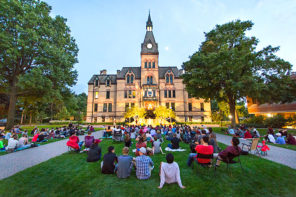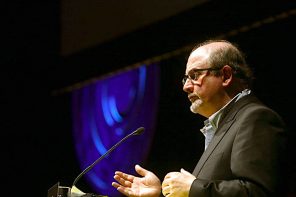Libyans took to the streets in protest last Friday to drive out extremist militia groups, one of which has been linked to the deadly attack on American officials in Benghazi on the 11th of September. On Saturday night Mohammed al-Megarief, head of the Libyan national assembly, announced that the government was “disbanding all the armed groups that do not fall under the authority of the government,” and the Guardian reports that five militias have fled or disbanded as of Sunday.
A little more than a week ago I wrote about “Innocence of Muslims”—the video on the Prophet Muhammad thought to be produced by Coptic ex-patriot Nakoula Basseley Nakoula, a.k.a. “Sam Bacile.” This week, shortly after arriving in Istanbul, I went to a local electronics store to get the ubiquitous, and indispensable, cell phone, when I was approached by a Libyan customer. After learning that I was an American he said “Thank you for helping liberate my country from the dreaded dictator, Gaddafi. May he burn in hell! And as for those who killed your ambassador, may they burn in hell with him!”
“They are a disgrace,” he said of the makers of the inflammatory video, “but they are not the cause for such outcry. Others are fomenting what is now called ‘rage’. We need courage not outrage, to chart a better government, a brighter future, for ourselves, our country, our region.”
We went on to discuss many other subjects—his work as a doctor in Libya during the battle; the wounded he had cared for; the dying he could not save; the displacement, shock, and bewilderment of so many of his countrymen. But he kept circling back to the concept of ‘rage’. “There is no rage among my people, just determination to change, to never go back to the tyranny of the past.” He managed a smile and a handshake before he and his family returned to Tripoli.
Bash of Civilizations
What is it about rage that pervades so much thinking about Islam in general, and Muslim reactions to perceived insults against them and their Prophet? For starters, pick up the latest issues of Time and Newsweek, still the two leading weekly magazines, known to all Americans and read by many—especially in airports.
On my flight to Istanbul, Time was available in the first airport lounge, Newsweek in the second. Against a backdrop of shouting mobs, smoke and fire, Time’s headline reads:
THE
AGENTS
OF
OUTRAGEAn embassy attacked.
Diplomats murdered.
The new calculus of violence
against America.
Published on September 13, its author is Bobby Ghosh, senior editor for Time International. Then, from the echo chamber, Newsweek followed suit on September 17 with a controversial cover featuring a closeup of two shouting, turbaned, bearded men in a throng of like-minded protesters, under the title:
MUSLIM RAGE
Its subtitle drew attention to the personal story of its author:
HOW I SURVIVED IT
HOW WE CAN END IT
That survivor, of course, is Aayan Hirsi Ali, a Somali refugee who fled to Holland, before landing in the United States. Her husband is the British historian Niall Ferguson (an Oxford-Harvard professor of empire).
There are many differences between the two articles and between the two authors. Ghosh is a professional journalist with a commitment to neutral reportage, while Ali is a professional polemicist, an unabashed critic of both the religion she left (Islam) and the community it projects (Arab-African-Asian Muslim nations). Ghosh and Hirsi Ali focus on the thin line between hatred and defamation, but while Ghosh finds blame on both sides, Hirsi Ali sees fault only with the Muslim protesters. She begins and ends with Rushdie, the victim of Khomeini’s fatwa in 1989 for his satirical novel, The Satanic Verses. Ghosh, for his part, cites not just Rushdie but several others who have contributed to the current crisis, including Hirsi Ali’s Dutch colleague, the assassinated provocateur/filmmaker Theo Van Gogh, and the Danish cartoonists who satirized the Prophet Muhammad in September 2005.
But the two authors also share one overriding similarity: focus on rage/outrage as the key term for describing this moment in Muslim-Western relations. Why does the doublet—rage/outrage—appear as the dominant image to reflect Muslim responses to what seems to be provocation at best and blasphemy at worst, from an Islamic perspective? Neither cover story attempts to provide the genealogy of rage/outrage, which needs to be traced; its source tells much about its original, durative power.
It comes not from 9/11, but from the end of the Cold War, and it comes not from Samuel Huntington, the Harvard political science professor and his (in)famous “clash of civilizations,” but from Bernard Lewis, the Princeton history professor. It was in 1990 that Lewis coined the term in a 1990 essay titled “The Roots of Muslim Rage.” Samuel Huntington admits he picked it up from Lewis.
Lewis’ argument is at once simple and simplistic: the West—what used to be known as Christendom—is now in the last stages of a centuries-old struggle for dominance and prestige with Islamic civilization. Since the end of World War II, but even more since the end of the Cold War (1989), the defeated Islamic forces seek revenge from the margins, whether through terrorist activities or public demonstrations.
While the Arab Spring may seem to have boded change, it was just a temporary blip according to the rage advocates, and now we see further outbursts of what remains a fierce, simmering rage against U.S. influence, marked not only by world dominance but also by local occupying forces in Iraq and Afghanistan.
A visual counterpoint to this perspective has been provided by Al-Jazeera English in a documentary first aired in late 2011 and repeatedly since. The 9/11 Decade tells the inside story of the 21st century’s most significant conflict in three one-hour episodes: “The Intelligence War,” “The Image War,” and “The Clash of Civilizations?” which strives to make three points: that al-Qaeda lost the intelligence war, rather than the CIA winning it; that al-Qaeda had a remarkably efficient propaganda machine, but disbanded it; and that far from a war of civilizations between the West and Islam, fueled by extremists on both sides, we now have democratic uprisings across the Arab world.
According to many commentators, the Arab Spring has turned into a Summer, and now Fall, of discontent. “Rage” remains the favorite descriptor, not just for Lewis and his ilk, but for all those who want to argue that freedom must be tolerated and defended by free societies. The reverse is also true, in their view: that the apparent rejection of free speech by Muslims and offended others demonstrates that their minds, as well as their bodies and their polities, are shackled; they will never be free unless or until they embrace freedom as an absolute, unqualified good.
In light of this genealogy, one must recognize the beguiling simplicity of the blame game—that ‘rage’ is entirely the problem of those enraged. They are not like us. They take religion to be a sacred cow, while we know that freedom of expression is the first, fundamental, basis of democracy, and that the West, as also the Western way of life, and Western civilization, depends on untrammeled freedom.
But what about hate speech? Is hate speech not a category that impinges on, and limits, the practice of free speech? Must Jews ‘tolerate’ neo-Nazis? Must Catholics tolerate one who suggests that the birth of Jesus was not immaculate, that he was instead conceived by ordinary human means, outside Jewish law and beyond the awareness or participation of Mary’s lawful husband? Does it matter if Hitler is proclaimed a god, and Jesus a bastard?
The self-appointed custodian of limitless freedom of speech would say: No. Take the poison with the perfume. It may hurt, but restricting it or any form of insult is worse. It undermines the basis of a democratic, inclusive worldview; it cuts to the core of Western civilization.
Should Muslim sensitivities be viewed any differently from their Jewish or Christian counterparts? Muslims do monitor their prophet. His legacy has been challenged within Islam at many levels, but his basic character has not been besmirched with the degree of ill will, bordering on savagery, that has been seen in the past 12 years.
The assault on Muhammad is not due to 9/11, but to the power of the image of ‘rage’, Muslim rage/outrage, that goes back to Lewis. This point of view finds Muslims exceptional not in their devotion to their Prophet but in their unwillingness to be modern and free. And this negative image of ‘Muslim exceptionalism’ also exists among extreme Copts in Egypt and the Hindu right in India.
Google-ocracy
But two years into the second decade of the 21st century we’re seeing a difference, not only in the assault on Islam, but in the Muslim response to that assault. The difference between today and yesterday, between the Muhammad video and Rushdie’s Satanic Verses, is the rapidity and ubiquity of image-making. Images can be, and are, made and remade, remixed, and disseminated with lightning speed on the Internet. It’s no accident that there was a long period of ‘silence’ between 1990-2004, with comparatively few assaults on Muslim norms. The Internet was still in the early stages of its global remapping of sensibilities. After 2004, however, the wounds of the 9/11 attacks, and the U.S./Allies’ response to those attacks, made the ground fertile for bashing Muslims.
Among the interest groups and institutions that have made the current phase so much more explosive is Google, the largest search engine on the Internet. The response of Google management to the Bacile/imbecile YouTube video illustrates the dilemma of virtual power: Google has the ironic function of providing, then patrolling, what is available on Google-owned YouTube.
Google’s policy is to remove content only if it is hate speech, which violates its terms of service, or in response to valid court orders or government requests. After determining at first that, under its own guidelines, the offensive video was not hate speech, Google eventually announced that, “given the very difficult situation in Libya and Egypt we have temporarily restricted access in both countries.”
Yet millions of people across the Muslim world viewed the video as one of the most inflammatory pieces of content on the Internet. From Afghanistan to Libya, authorities have been scrambling to contain an outpouring of popular protest and have repeatedly called on the United States to take measures against its producers.
Google’s actions raises fundamental questions about the control that Internet companies have over online expression. Should companies themselves decide what standards govern what is seen on the Internet? How consistently should these policies be applied?
Under YouTube’s terms of service, hate speech must be directed against individuals, not groups. Because the video mocks Islam but not Muslim people, it has been allowed to stay on the site in most of the world: “This video—which is widely available on the Web—is clearly within our guidelines and so will stay on YouTube,” it said.
Google is, in effect, walking a precarious line between advocacy of free speech and incitement to violence. Blocking the video might encourage copycat endeavors to prohibit other material, yet most would no doubt agree that endless provocation of violence must also be avoided—or at least mitigated.
All companies that allow people to post content online—Facebook and Twitter, as well as Google—have grappled with similar issues, which are complicated by the lack of geographical boundaries and the burden of navigating a morass of laws and cultural mores. Consider that requests for content removal from United States governmental agencies and courts have doubled over the course of the past year, with 279 requests to remove 6,949 items, according to Google. Members of Congress have publicly requested that YouTube take down jihadist videos that they say incite terrorism, and in some cases YouTube has agreed.
Google has continually fallen back on its guidelines to remove only content that breaks laws or its terms of service, whether the request came from governments or courts, which is why blocking the anti-Islam video was exceptional. Some wonder what precedent this might set, especially for government authorities keen to stanch expression that they think will inflame their populace.
The latest to pile on is the French satirical magazine Charlie Hebdo. Last Wednesday, issues of the magazine hit newsstands with a front cover showing an Orthodox Jew pushing a turbaned figure in a wheelchair with several caricatures of the Prophet on its inside pages, including some of him naked. In an exclusive interview with Al Jazeera last Friday, the editor defended his decision to publish these cartoons arguing that the problem is the indignant, violent reaction of Muslims. He says nothing wrong has been done, and that his magazine hasn’t violated French law, where a publication has the right to run critical or satirical cartoons.
The Charlie Hebdo cartoons have garnered less ‘sacred rage’ than the “Innocence of Islam” video, perhaps because they’re in print and not on film; images move, but moving images move faster and wound more deeply. And it’s crucial to recognize that the Muslim world does not speak with one voice, or march to one tune. There are many, many Muslims who are prone not to rage but to courage, as the popular uprising against militias in Libya (and the gentleman in the cell phone store) attest.
This perspective often goes unreported but can be sighted in various locales throughout the Mediterranean and Asian world of Islam, and they are more in need of support than those, from both sides, who want only to find, to stress, and to proliferate ‘Muslim rage.’




